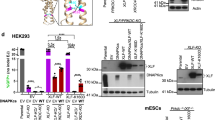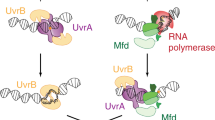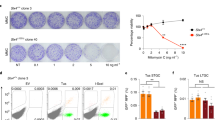Abstract
We present the Flp-nick system, which allows introduction of a protein-bound nick at a single genomic site in Saccharomyces cerevisiae and thus mimics a stabilized topoisomerase I–DNA cleavage complex. We took advantage of a mutant Flp recombinase that can introduce a nick at a specific Flp recombinase recognition target site that has been integrated in the yeast genome. The genetic requirement for cells to cope with this insult is the same as for cells treated with camptothecin, which traps topoisomerase I–DNA cleavage complexes genome-wide. Hence, a single protein-bound nick is enough to kill cells if functional repair pathways are lacking. The Flp-nick system can be used to dissect repair, checkpoint and replication fork management pathways activated by a single genomic insult, and it allows the study of events at the damage site, which so far has been impossible to address.
This is a preview of subscription content, access via your institution
Access options
Subscribe to this journal
Receive 12 print issues and online access
$259.00 per year
only $21.58 per issue
Buy this article
- Purchase on Springer Link
- Instant access to full article PDF
Prices may be subject to local taxes which are calculated during checkout


Similar content being viewed by others
References
Bjergbaek, L., Cobb, J.A., Tsai-Pflugfelder, M. & Gasser, S.M. Mechanistically distinct roles for Sgs1p in checkpoint activation and replication fork maintenance. EMBO J. 24, 405–417 (2005).
Cobb, J.A. et al. Replisome instability, fork collapse, and gross chromosomal rearrangements arise synergistically from Mec1 kinase and RecQ helicase mutations. Genes Dev. 19, 3055–3069 (2005).
Lopes, M., Foiani, M. & Sogo, J.M. Multiple mechanisms control chromosome integrity after replication fork uncoupling and restart at irreparable UV lesions. Mol. Cell 21, 15–27 (2006).
Lucca, C. et al. Checkpoint-mediated control of replisome-fork association and signalling in response to replication pausing. Oncogene 23, 1206–1213 (2004).
Ahn, J.S., Osman, F. & Whitby, M.C. Replication fork blockage by RTS1 at an ectopic site promotes recombination in fission yeast. EMBO J. 24, 2011–2023 (2005).
Calzada, A., Hodgson, B., Kanemaki, M., Bueno, A. & Labib, K. Molecular anatomy and regulation of a stable replisome at a paused eukaryotic DNA replication fork. Genes Dev. 19, 1905–1919 (2005).
Lambert, S., Watson, A., Sheedy, D.M., Martin, B. & Carr, A.M. Gross chromosomal rearrangements and elevated recombination at an inducible site-specific replication fork barrier. Cell 121, 689–702 (2005).
Kramer, K.M., Brock, J.A., Bloom, K., Moore, J.K. & Haber, J.E. Two different types of double-strand breaks in Saccharomyces cerevisiae are repaired by similar RAD52-independent, nonhomologous recombination events. Mol. Cell. Biol. 14, 1293–1301 (1994).
Lee, J. & Jayaram, M. A tetramer of the Flp recombinase silences the trimers within it during resolution of a Holliday junction substrate. Genes Dev. 11, 2438–2447 (1997).
Wang, J.C. Cellular roles of DNA topoisomerases: a molecular perspective. Nat. Rev. Mol. Cell Biol. 3, 430–440 (2002).
Lee, J., Jayaram, M. & Grainge, I. Wild-type Flp recombinase cleaves DNA in trans. EMBO J. 18, 784–791 (1999).
Lee, J., Whang, I. & Jayaram, M. Assembly and orientation of Flp recombinase active sites on two-, three- and four-armed DNA substrates: implications for a recombination mechanism. J. Mol. Biol. 257, 532–549 (1996).
Voziyanov, Y., Lee, J., Whang, I., Lee, J. & Jayaram, M. Analyses of the first chemical step in Flp site-specific recombination: synapsis may not be a pre-requisite for strand cleavage. J. Mol. Biol. 256, 720–735 (1996).
Parsons, R.L., Prasad, P.V., Harshey, R.M. & Jayaram, M. Step-arrest mutants of FLP recombinase: implications for the catalytic mechanism of DNA recombination. Mol. Cell. Biol. 8, 3303–3310 (1988).
Nitiss, J. & Wang, J.C. DNA topoisomerase-targeting antitumor drugs can be studied in yeast. Proc. Natl. Acad. Sci. USA 85, 7501–7505 (1988).
Downs, J.A., Lowndes, N.F. & Jackson, S.P. A role for Saccharomyces cerevisiae histone H2A in DNA repair. Nature 408, 1001–1004 (2000).
Pouliot, J.J., Yao, K.C., Robertson, C.A. & Nash, H.A. Yeast gene for a Tyr-DNA phosphodiesterase that repairs topoisomerase I complexes. Science 286, 552–555 (1999).
Yang, S.W. et al. A eukaryotic enzyme that can disjoin dead-end covalent complexes between DNA and type I topoisomerases. Proc. Natl. Acad. Sci. USA 93, 11534–11539 (1996).
Bastin-Shanower, S.A., Fricke, W.M., Mullen, J.R. & Brill, S.J. The mechanism of Mus81-Mms4 cleavage site selection distinguishes it from the homologous endonuclease Rad1-Rad10. Mol. Cell. Biol. 23, 3487–3496 (2003).
Doe, C.L., Ahn, J.S., Dixon, J. & Whitby, M.C. Mus81-Eme1 and Rqh1 involvement in processing stalled and collapsed replication forks. J. Biol. Chem. 277, 32753–32759 (2002).
Vance, J.R. & Wilson, T.E. Yeast Tdp1 and Rad1-Rad10 function as redundant pathways for repairing Top1 replicative damage. Proc. Natl. Acad. Sci. USA 99, 13669–13674 (2002).
Davies, D.R., Interthal, H., Champoux, J.J. & Hol, W.G. Crystal structure of a transition state mimic for Tdp1 assembled from vanadate, DNA, and a topoisomerase I-derived peptide. Chem. Biol. 10, 139–147 (2003).
Koster, D.A., Palle, K., Bot, E.S., Bjornsti, M.A. & Dekker, N.H. Antitumour drugs impede DNA uncoiling by topoisomerase I. Nature 448, 213–217 (2007).
Longtine, M.S. et al. Additional modules for versatile and economical PCR-based gene deletion and modification in Saccharomyces cerevisiae. Yeast 14, 953–961 (1998).
Torres-Rosell, J. et al. The Smc5-Smc6 complex and SUMO modification of Rad52 regulates recombinational repair at the ribosomal gene locus. Nat. Cell Biol. 9, 923–931 (2007).
Strahl-Bolsinger, S., Hecht, A., Luo, K. & Grunstein, M. SIR2 and SIR4 interactions differ in core and extended telomeric heterochromatin in yeast. Genes Dev. 11, 83–93 (1997).
Frei, C. & Gasser, S.M. The yeast Sgs1p helicase acts upstream of Rad53p in the DNA replication checkpoint and colocalizes with Rad53p in S-phase-specific foci. Genes Dev. 14, 81–96 (2000).
Sugawara, N. & Haber, J.E. Repair of DNA double strand breaks: in vivo biochemistry. Methods Enzymol. 408, 416–429 (2006).
Lisby, M., Rothstein, R. & Mortensen, U.H. Rad52 forms DNA repair and recombination centers during S phase. Proc. Natl. Acad. Sci. USA 98, 8276–8282 (2001).
Acknowledgements
We thank M. Gartenberg (Robert Wood Johnson Medical School) for plasmids pFV17D-H305L and pFV17D and yeast strain ELT3; and M. Schmid (University of Aarhus) for comments on the manuscript. This work was supported by grants from the Danish Research Council (FNU 21-04-0354 and FNU 272-07-0366), Novo Nordisk Foundation, Aase and Einar Danielsens Foundation and Augustinus Foundation to L.B.; I.N. is supported by The Danish Cancer Society (DS07014); I.B.B. is supported by the Lundbeck Foundation (53/06) and M.L. is supported by The Danish Agency for Science, Technology and Innovation and the Villum Kann Rasmussen Foundation.
Author information
Authors and Affiliations
Contributions
I.N., I.B.B., M.L., S.H., K.M. and L.B. carried out experiments. L.B. and A.H.A. designed the system. L.B. wrote the manuscript.
Corresponding author
Supplementary information
Supplementary Text and Figures
Supplementary Figures 1–5, Supplementary Tables 1–2 and Supplementary Protocol (PDF 642 kb)
Rights and permissions
About this article
Cite this article
Nielsen, I., Bentsen, I., Lisby, M. et al. A Flp-nick system to study repair of a single protein-bound nick in vivo. Nat Methods 6, 753–757 (2009). https://doi.org/10.1038/nmeth.1372
Received:
Accepted:
Published:
Issue Date:
DOI: https://doi.org/10.1038/nmeth.1372
This article is cited by
-
Rpd3L and Hda1 histone deacetylases facilitate repair of broken forks by promoting sister chromatid cohesion
Nature Communications (2019)
-
Abortive activity of Topoisomerase I: a challenge for genome integrity?
Current Genetics (2019)
-
The Escherichia coli Tus–Ter replication fork barrier causes site-specific DNA replication perturbation in yeast
Nature Communications (2014)
-
Cohesin and the nucleolus constrain the mobility of spontaneous repair foci
EMBO reports (2013)
-
Increased mobility of double-strand breaks requires Mec1, Rad9 and the homologous recombination machinery
Nature Cell Biology (2012)



